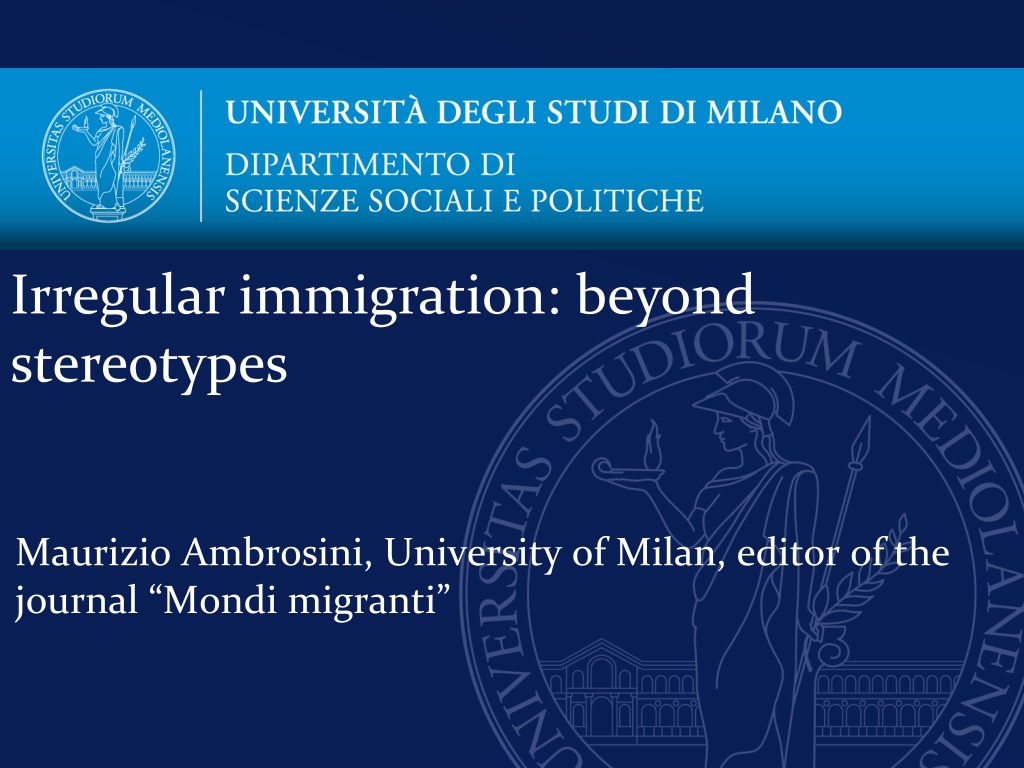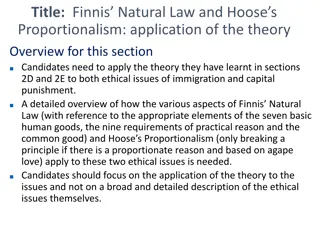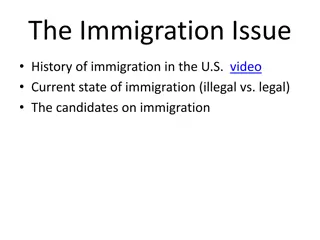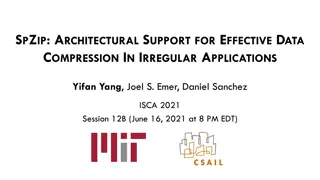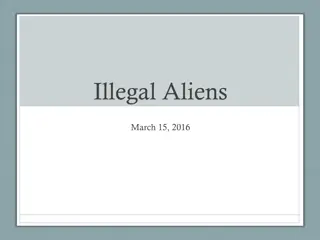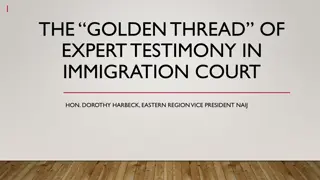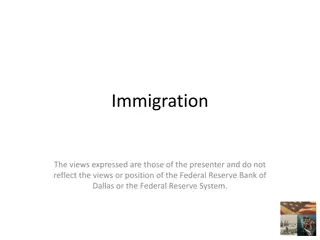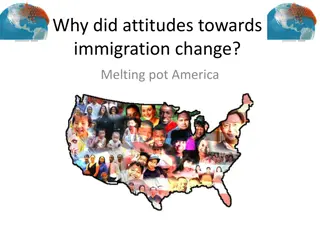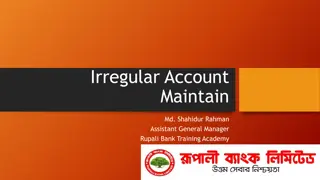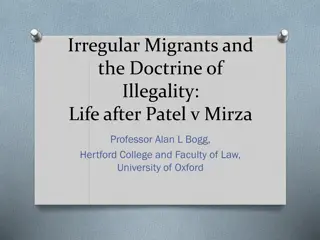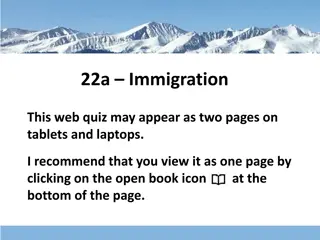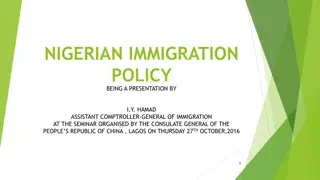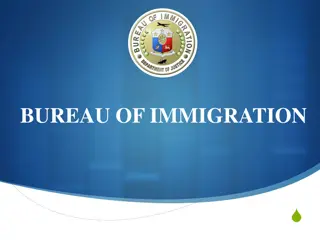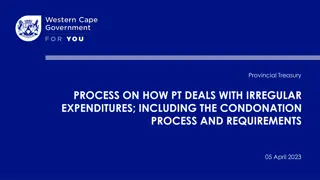Understanding Irregular Immigration Beyond Stereotypes
The issue of irregular immigration has gained prominence in recent decades, particularly in the context of increased immigration policies and border closures. While there is a general trend towards more restrictions on immigration in Europe and the Global North, there remains a lack of clarity on what constitutes irregular immigration and who qualifies as an irregular immigrant. Various factors contribute to irregular migrations, including labor market demands, vested interests, liberal constraints, normative production of illegality, and migrants' agency. Different perspectives view irregular migrants as villains, victims, or heroes of globalization from below, highlighting the complexity of this issue.
Download Presentation

Please find below an Image/Link to download the presentation.
The content on the website is provided AS IS for your information and personal use only. It may not be sold, licensed, or shared on other websites without obtaining consent from the author. Download presentation by click this link. If you encounter any issues during the download, it is possible that the publisher has removed the file from their server.
E N D
Presentation Transcript
Irregular immigration: beyond stereotypes Maurizio Ambrosini, University of Milan, editor of the journal Mondi migranti
A recent issue Immigration policies have increased in their importance in the political agenda, in Europeand elsewhere The issue of irregular migrations is quite recent: it has acquired salience only in the 70, in relation with the political choice to close the borders against economic immigrants Only in the 90 provisions have become more stringent (technologies of identification, exclusion from welfare rights), and after 2001 security goals have been meshed with immigration control
The general trend The general trend in Europe and in the Global North is towards more closure: voters seem to demand more restrictions on further admissions of migrants, rights, diversity New political parties have gained ground, with big success in several opposition to immigrants and cultural diversity In US the debate on what to do of about 11 millions of irregular immigrants is still very hot and tolerance towards countries, emphasizing
The puzzle of irregularity It is not clear what is irregular immigration and who is an irregular immigrant Irregularity in the access to a country or in the residence in the country (most of irregular immigrants enter in a regular way, as tourists, students, pilgrims, asylum seekers, sportspersons ) Irregularity in residence, in work, in documentation Difficulty (and costs) in handling the condition of irregular residents, in implementing deportations, in punishing the employers
The causes of irregular migrations Labour market demands Other vested interests (tourism, international trade, cultural exchanges, etc.) Liberal constraint: the embedded liberalism and human rights Normative production of illegality (e.g.: family reunions) Migrants agency: the action of the networks Lack of ressources, inefficiency of the repressive system
Four visions of irregular migrants The main vision: irregular migrants as vilains (B.Anderson) The opposite vision: irregular migrants as victims An alternative: the heroes of the globalization from below An other vision: undocumented migrants as actors struggling for a better life, embedded in networks, sponsored by native families and solidarity institutions
Not all the irregular immigrants are equal Irregular immigration as a dynamic concept: especially in Europe, few irregular immigrants are actually deported In fact, host societies distinguish and classify various types of irregular immigrants On the other hand, immigrants develop forms of irregularity negotiation with both the networks of compatriots and the receiving societies They invent practices of survival, seeking to develop some sort of moral economy of migrant illegality (Chauvin and Garc s Mascare as, 2014)
Social acceptance and official recognition Social Acceptance No Yes No Exclusion Not accepted, not recognized (e.g., Jobless irregular immigrants) Tolerance Accepted, but not recognized (e.g.: irregular careworkers) Official Recognition Yes Stigmatization Recognized, but not accepted (e.g. asylum seekers and refugees) Integration Regular immigrants in paid employment (but: subordinate integration)
Irregular condition as a passage In the period 1996-2008 in the European Union about 5-6 million of migrants (ICMPD 2009) have passed from an irregular status into a regular one. Among 27 EU countries, 22 have adopted some measures of regularization. Southern Europe is at the forefront The enlargement of EU to Eastern Europe has been a non declared measure of regularisation The official policy has hardened, but actual policies are not so rigid: a distance between rhetoric and practice The irregular condition, so becomes a temporary and changeable status for many migrants.
The irregular condition as a pathway - The arrival and inclusion, supported mainly by networks - The phase of survival in the shadow, supported mainly by employers - The emergence stage, during the periodical campaigns of regularization, supported also by NGOs
Transition towards legal status Admission devices Legalization forms Possibilities for initiative by immigrants Regularization procedures, amnesties Deservingness Demonstrate integration into the labor market or social relationships Assessment of particular biographical conditions Liberal protection Demonstrate possession of the right requirements Recognition of a condition of danger or abuse Victimization Demonstrate real victimhood
Types of intermediaries and functions performed Types of intermediaries Functions performed Beneficiaries Employers (households included) Provision of employment opportunities Immigrant workers Co-ethnic brokers Matching labourdemand and supply Fellow job seekers and native employers Smugglers Assistance in crossing borders; provision of forged documents Migrants not able to entry a country with regular documents NGOs Provision of services Migrants with special needs for a structured supply Ordinary (native) citizens Provision of immediate aid Especially immigrants in need and personally known Civil servants Benevolent interpretation of the rules, abstention from Immigrants judged deserving, not dangerous or
Intermediation Activities Matching opportunities work, information and reference Legal, semi-legal and illegal supply of resources demand by migrants Concrete and support to people in need Actors Various types of brokers on both sides movements migrants for with travel, through Connection of migrant settlement, Different legal and illegal, formal and informal, acting for profit or forethical reasons Common citizens providers, both Provision services of on irregular personal Help Abstention controls from tighter Mainly sometimes also NGO officers civil servants and Tolerance Lobbying for migrants rights Collective actors: NGOs, religious social Political pressure trade institutions, movements unions,
Various types of smugglers and smuggling activity Legal agencies providing illegal services Illegal agencies providing illegal services Casual smugglers (and even unaware) Small scale networks, focused only on a single border or on a single activity Large scale networks, providing multiple services (van Liempt 2007)
Various types of journeys (UNHCR on Lybia) Organized journeys are akin to a complete travel package deal from country of origin to country of destination. They are more rapid and costly Step-by-step journeys are fragmented into several legs, and are organized by refugees and migrants themselves.
UNHCR on Lybia Smuggling can take very different forms, from highly-structured, hierarchical organisations to loosely-connected, informal, horizontal networks Smuggling networks can involve a variety of stakeholders and intermediaries. Sea crossings are often organized from coastal areas by different smuggling networks than those who help people to move up through the country on land. transnational
Different tasks of smugglers Guides, drivers, intermediaries (professional or not): Belloni on Eritrea Migration brokers (Alpes on Cameroon) Transporters, coordinators/ wholesalers, intermediaries, other facilitators and specialist service providers: shelter providers; spotters and security providers; cashiers; financers (UNHCR on Lybia)
Four main forms of action (NGOs) Promoting networks Protesting and lobbying Producing services Providing access to rights through legal action (advocacy)
Street level bureaucracies resistance to the application of restrictive rules considered to conflict with professional ethics abstention from controls potentially threatening, or the use of selective and targeted controls informal networks between public services and civil society organizations advice and practical help in understanding procedures and correctly compiling the forms power to interpret the rules and procedures corruption
Rethoric and reality of the repression of irregular immigration Italy is the EU country that has granted the highest number of regularizations, through seven amnesties in 25 years, and other forms of hidden regularization Between 2002 and 2012, more than one million of migrants were explicitly regularized, and many other migrants have been regularized implicitly by other procedures In 2018 and 2019, against an estimate of about 500-600,000 undocumented immigrants, expulsions have been about 6,000 Places available in the Identification and Expulsion Centres are less than 2,000 in all the country
The Italian case: irregular immigration and invisible welfare In Italy, as in other countries, a huge number of immigrants are employed as domestic workers, baby-sitters or carers of the elderly in Italian families (officially 700-800,000, in reality probably more than one million) The families, as employers, have been the main actors of the regularization process When it comes to women engaged in household chores and care, the unwritten rule is almost that of a generalized tolerance. One could say that they are not politically treated, nor socially perceived as illegal immigrants
The three hands of the receiving States: 1) they create the conditions for the demand: subcontracting, flexibilization, reduction of welfare provisions, etc.; 2) they declare to want to stop illegal immigration; 3) they regularize undocumented migrants (specially in the care sector) The irregular condition as a dynamic social construction, where different actors and structural forces are involved. See: M.Ambrosini, Irregular migration and invisible welfare, Palgrave-MacMillan 2013; or: M.Ambrosini, Immigrazione irregolare e welfare invisibile. iI lavoro di cura attraverso le frontiere, Bologna, Il Mulino 2013
Conclusions The fight against illegal immigration proclaimed by governments is counteracted by diverse interests and social representations of the phenomenon that tend to redefine it selectively The deserving irregular immigrant is treated in a different way from the unwanted one immigration defined as illegal should be understood in dynamic terms, not as an indelible stigma the exclusion of irregular immigrants is not absolute and without appeal NGOs help to fill the gap between abstract rules and actual situations The state institutions (and their bureaucracies) are not solely hostile forces
